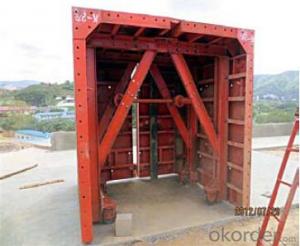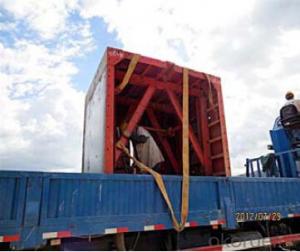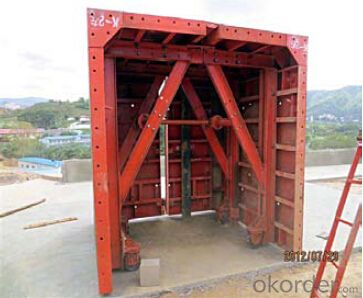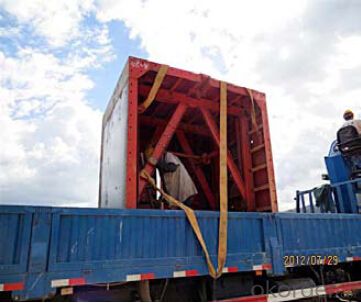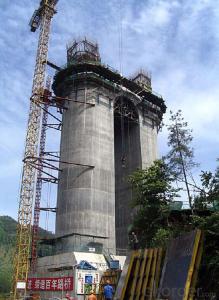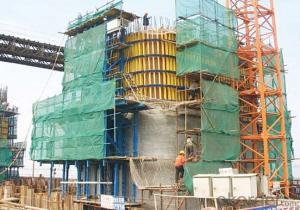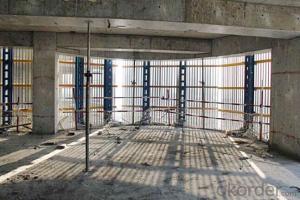Steel-Tunnel for formwork and scaffolding systems
- Loading Port:
- Tianjin
- Payment Terms:
- TT OR LC
- Min Order Qty:
- 50 m²
- Supply Capability:
- 1000 m²/month
OKorder Service Pledge
Quality Product, Order Online Tracking, Timely Delivery
OKorder Financial Service
Credit Rating, Credit Services, Credit Purchasing
You Might Also Like
Building Tunnel Formwork:
A compositional steel formwork system mainly used in the building which has regular structure
without beams, the excellent formwork system can make the integral pouring for the wall & slab
easily achieved.
Characteristics:
◆ High stiffness, make perfect shape for concrete.
◆ Easy operation, save labor and force.
◆ Fast forming, repeatedly turnover.
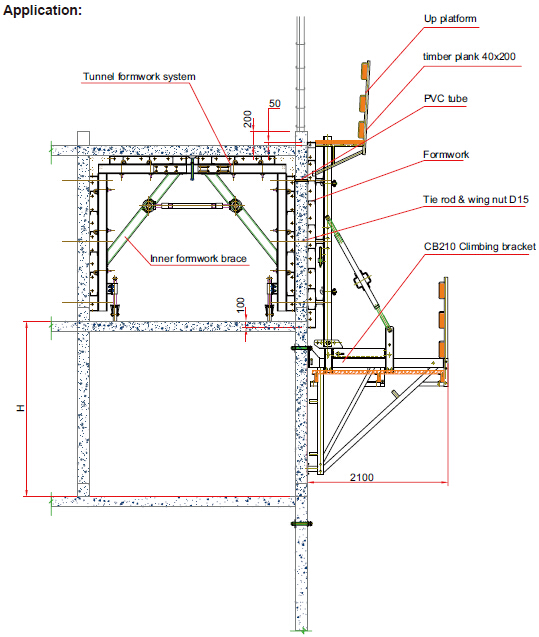
- Q: What are the common durability issues with steel formwork systems?
- Some common durability issues with steel formwork systems include rusting, corrosion, and wear and tear due to repeated use. Over time, exposure to moisture, chemicals, and harsh weather conditions can cause the steel to degrade, leading to weakened structural integrity and potential safety hazards. Regular maintenance and proper storage can help mitigate these issues and extend the lifespan of steel formwork systems.
- Q: Can steel formwork be easily dismantled and removed after construction?
- Steel formwork is designed to be easily dismantled and removed after construction, providing a cost-effective and sustainable option for construction projects. It can withstand the weight and pressure of the concrete during the construction process. Once the construction is complete and the concrete has cured, the steel formwork can be dismantled using basic tools like hammers and wrenches. The individual components of the formwork can be unbolted and removed from the concrete structure. After dismantling, the steel formwork can be cleaned, inspected, and stored for future use, reducing the need for new formwork in future construction projects. In conclusion, the use of steel formwork offers the advantage of easy dismantling and removal, contributing to its cost-effectiveness and sustainability in construction projects.
- Q: Can steel formwork be used for both straight and sloping structures?
- Indeed, both straight and sloping structures can make use of steel formwork. This construction material, known for its versatility and flexibility, has the capability to be tailored to fit diverse shapes and configurations. It can be effortlessly modified and fastened to produce straight walls and columns. Furthermore, by employing specialized accessories and components, steel formwork can be adjusted to construct sloping structures like ramps, inclined walls, and curved surfaces. These characteristics of adaptability and flexibility render steel formwork highly favored in construction projects that entail diverse design specifications.
- Q: Can steel formwork be used in hotel or hospitality construction projects?
- Steel formwork is a viable option for hotel or hospitality construction projects. It offers numerous advantages compared to other formwork types like wood or concrete. Primarily, steel formwork boasts exceptional durability, allowing it to withstand the heavy loads and pressures associated with construction endeavors. This makes it suitable for constructing hotels with large and intricate structures. Secondly, steel formwork is reusable, resulting in cost savings and reduced construction time. This proves particularly advantageous in hotel or hospitality projects where efficiency and promptness are crucial. Moreover, steel formwork ensures a smooth and high-quality finish on concrete surfaces. This is especially vital in the hotel and hospitality industry, where aesthetics play a significant role. The sleek finish provided by steel formwork enhances the overall appearance of hotels, creating a visually appealing and luxurious environment for guests. Additionally, steel formwork allows for greater design flexibility as it can be easily shaped and adjusted to meet specific project requirements. This is a valuable asset in hotel or hospitality construction projects, where unique and personalized designs are often desired to create a distinct and memorable guest experience. In conclusion, steel formwork is a suitable choice for hotel or hospitality construction projects due to its durability, reusability, ability to provide a smooth finish, and flexibility in design.
- Q: What are the different types of steel formwork supports?
- There are several types of steel formwork supports, including adjustable steel props, steel beams, steel frames, and steel tubes.
- Q: How does steel formwork contribute to the overall efficiency of construction processes?
- There are various ways in which steel formwork enhances the efficiency of construction processes. To begin with, it is highly durable and long-lasting, allowing for multiple reuses across different projects. This eliminates the frequent need for replacements, resulting in time and cost savings. Moreover, steel formwork is easily assembled and disassembled, facilitating quick setup and dismantling on construction sites. This saves valuable time during the construction phase. Additionally, steel formwork guarantees superior finishes on concrete surfaces. Its smooth and even surface ensures accurate pouring and setting of the concrete, leading to well-finished products. Consequently, the need for additional finishing work is eliminated, reducing labor costs and time. The stability and rigidity of steel formwork also prevent any deformations or movements during the pouring and setting of concrete, resulting in precise and consistent outcomes. Moreover, steel formwork offers design flexibility. Its ability to be easily customized and adjusted to various shapes and sizes allows for versatility in construction projects. This adaptability minimizes the requirement for multiple types of formwork, streamlining the construction process. Furthermore, steel formwork is resistant to adverse weather conditions, chemicals, and moisture, ensuring its durability even in harsh environments. This resistance decreases the likelihood of damage or deterioration, reducing the need for repairs and replacements. The longevity of steel formwork contributes to cost savings and enhances the overall efficiency of construction processes. In conclusion, steel formwork significantly enhances the overall efficiency of construction processes through its durability, reusability, easy assembly, high-quality finishes, design flexibility, and resistance to weather and chemicals. These advantages save time, reduce costs, and ensure the completion of construction projects efficiently and effectively.
- Q: What are the considerations when designing steel formwork for foundations?
- When designing steel formwork for foundations, there are several important considerations that need to be taken into account. Firstly, the load-bearing capacity of the formwork needs to be carefully calculated and designed to ensure it can support the weight of the concrete being poured. The formwork must be able to withstand the pressure and weight of the liquid concrete without deforming or collapsing. The strength and thickness of the steel used for the formwork will play a crucial role in determining its load-bearing capacity. Another consideration is the shape and size of the foundation. The formwork needs to be designed to accurately replicate the desired shape and dimensions of the foundation. This requires careful planning and measurement to ensure the formwork is properly aligned and positioned before pouring the concrete. Any inaccuracies in the formwork can result in a foundation that is not level or properly aligned, which can compromise the structural integrity of the entire building. Furthermore, the formwork needs to be designed with the ease of installation and removal in mind. Steel formwork systems that are modular or adjustable can greatly improve the efficiency of the construction process. This allows for easy assembly and disassembly of the formwork, reducing labor and time requirements. Additionally, provisions should be made for easy access to the foundation for any necessary inspections or repairs during and after construction. Lastly, the durability and longevity of the steel formwork should be considered. Steel is known for its strength and durability, but precautions should still be taken to protect the formwork from environmental factors such as corrosion. Applying protective coatings or using galvanized steel can help prevent rust and extend the lifespan of the formwork. In summary, when designing steel formwork for foundations, considerations such as load-bearing capacity, accuracy of shape and size, ease of installation and removal, and durability are vital to ensure a successful and structurally sound foundation.
- Q: What are the considerations when designing steel formwork for underground parking structures?
- When designing steel formwork for underground parking structures, several key considerations should be taken into account. Firstly, the formwork must be able to withstand the heavy loads and pressures exerted by the surrounding soil and any potential water infiltration. It is crucial to ensure the strength, stability, and durability of the formwork system to prevent any structural failures or collapses. Additionally, careful attention should be paid to the formwork's waterproofing capabilities. Adequate waterproofing measures, such as the use of sealants or membranes, must be incorporated to protect the structure against potential water ingress, which could lead to corrosion and long-term damage. Moreover, the design should allow for efficient and safe construction. This includes considering factors such as ease of assembly and disassembly, ensuring proper access and working space for construction workers, and incorporating appropriate safety measures to prevent accidents during the formwork installation and removal processes. Lastly, the formwork design should also take into consideration the desired architectural and aesthetic elements of the parking structure. This may involve incorporating specific finishes, textures, or patterns on the exposed concrete surfaces, which can enhance the overall visual appeal of the underground parking facility. Overall, the considerations when designing steel formwork for underground parking structures revolve around ensuring structural integrity, waterproofing capabilities, construction efficiency, safety, and meeting the desired architectural requirements.
- Q: Can steel formwork be used for single-sided formwork applications?
- Steel formwork is an ideal option for single-sided formwork applications. Its durability and strength make it suitable for various construction projects, including those requiring single-sided formwork. This type of formwork is commonly used when only one side of the concrete structure is accessible, such as when constructing retaining walls, columns, or beams against existing structures. By providing the necessary support and stability, steel formwork holds the concrete in place until it cures and hardens. Its high level of accuracy and precision ensures that the concrete structure is formed correctly and meets the desired specifications. Moreover, steel formwork can be easily assembled and disassembled, facilitating efficient and rapid construction. Another advantage is that it can be reused multiple times, making it a cost-effective choice for single-sided formwork applications. All in all, due to its strength, durability, accuracy, and efficiency, steel formwork is a reliable and suitable option for single-sided formwork applications.
- Q: What is the lifespan of steel formwork?
- The lifespan of steel formwork can vary depending on various factors such as the quality of the steel, maintenance practices, and frequency of use. However, with proper care and maintenance, steel formwork can last for many years, potentially even decades.
Send your message to us
Steel-Tunnel for formwork and scaffolding systems
- Loading Port:
- Tianjin
- Payment Terms:
- TT OR LC
- Min Order Qty:
- 50 m²
- Supply Capability:
- 1000 m²/month
OKorder Service Pledge
Quality Product, Order Online Tracking, Timely Delivery
OKorder Financial Service
Credit Rating, Credit Services, Credit Purchasing
Similar products
Hot products
Hot Searches
Related keywords
